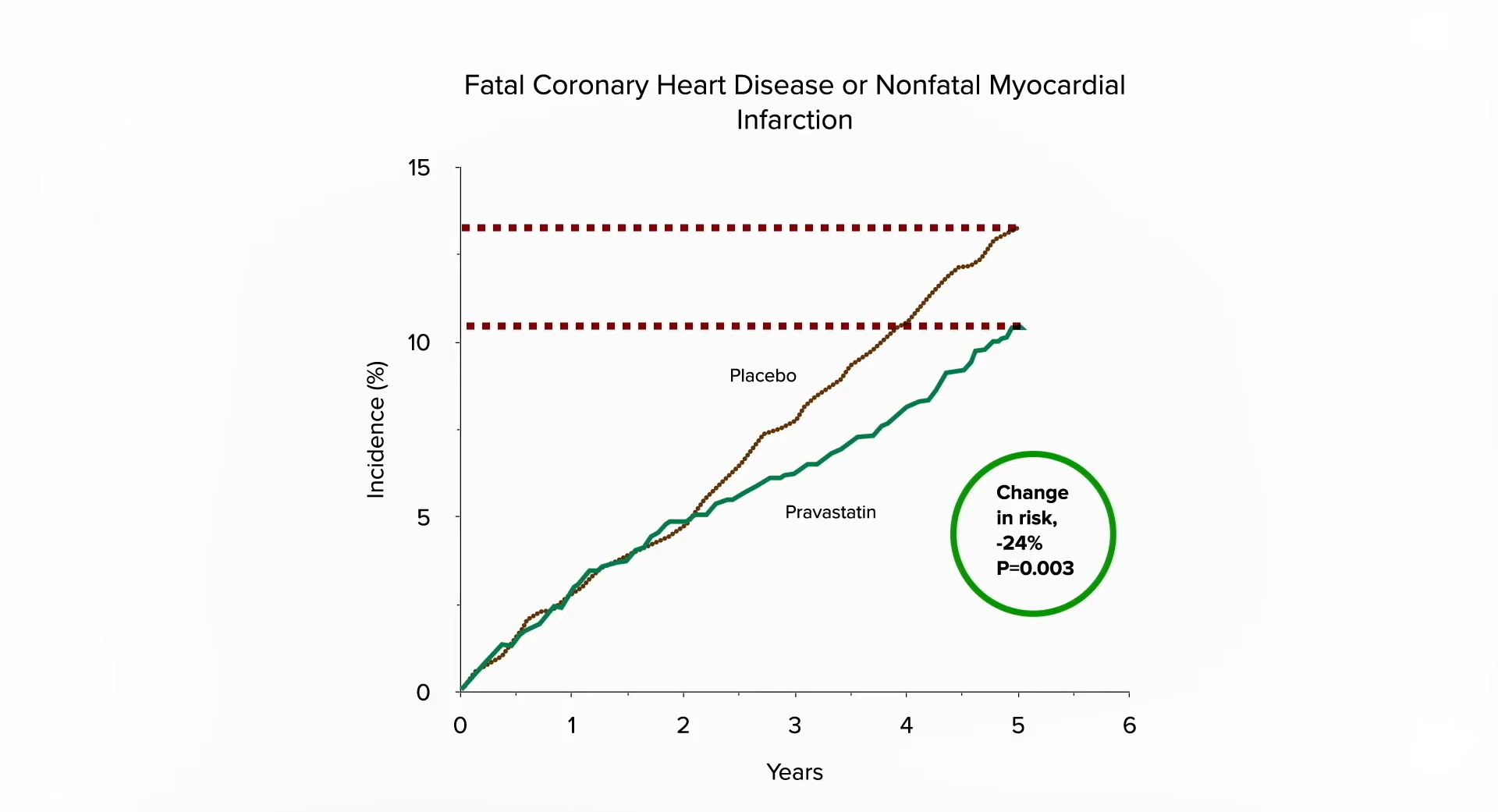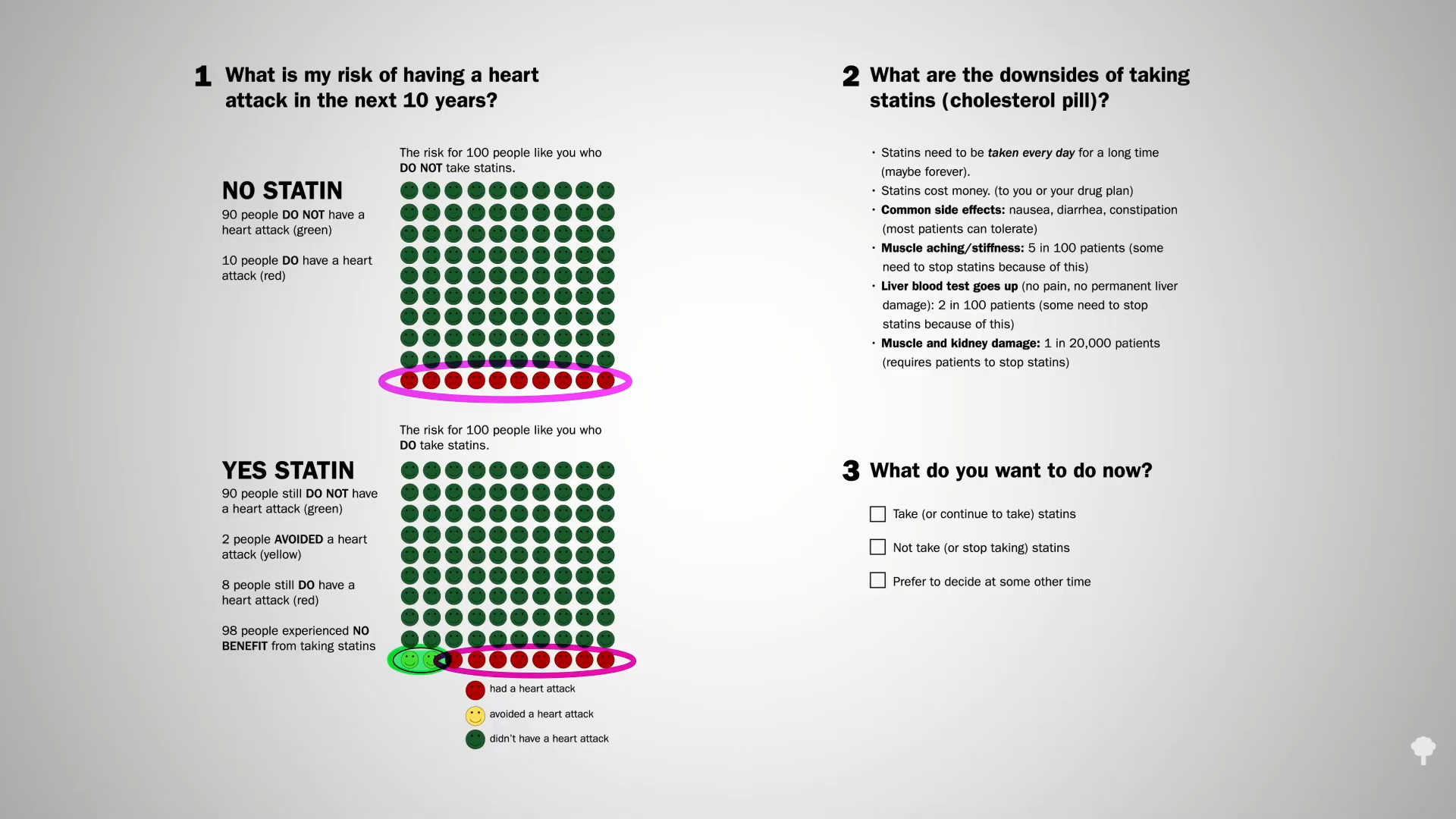A Mayo Clinic visualization device will help you resolve if cholesterol-lowering statin medicine are best for you.
“Physicians have an obligation to tell their sufferers in regards to the dangers and advantages of the interventions out there to them. Nevertheless, physicians not often talk with strategies that convey absolute info, corresponding to numbers wanted to deal with, numbers wanted to hurt, or prolongation of life, regardless of sufferers wanting this info.” That’s, for instance, how many individuals are literally helped by a selected drug, what number of are literally harm by it, or how for much longer the drug will allow you to dwell, respectively.
If docs inform sufferers solely in regards to the relative danger discount—for instance, telling them a capsule will reduce their danger of coronary heart assaults by 34 %—9 out of ten comply with take it. Nevertheless, give them the identical info framed as absolute danger discount—“1.4% fewer sufferers had coronary heart assaults”—then these agreeing to take the drug drops to solely 4 out of ten. And, in the event that they use the quantity wanted to deal with, solely three in ten sufferers would comply with take the capsule. So, in case you’re a health care provider and also you really need your affected person to take the drug, which statistic are you going to make use of?
The usage of relative danger stats to inflate the advantages and absolute danger stats to downplay any uncomfortable side effects has been referred to as “statistical deception.” To see how one would possibly spin a examine to perform this, let’s take a look at an instance. As you’ll be able to see beneath and at 1:49 in my video, The True Benefits vs. Side Effects of Statins, there’s a considerably decrease danger of the incidence of coronary heart assault over 5 years in examine contributors randomized to a placebo in comparison with these getting the drug. If you happen to needed statins to sound good, you’d use the relative danger discount (24 % decrease danger). If you happen to needed statins to sound unhealthy, you’d use absolutely the danger discount (3 % fewer coronary heart assaults).

Then you would flip it for uncomfortable side effects. For instance, the researchers discovered that 0.3 % (1 out of 290 girls within the placebo group) obtained breast most cancers over 5 years, in comparison with 4.1 % (12 out of 286) within the statin group. So, a pro-statin spin may be a 24 % drop in coronary heart assault danger and solely 3.8 % extra breast cancers, whereas an anti-statin spin might be solely 3 % fewer coronary heart assaults in comparison with a 1,267 % larger danger of breast most cancers. Each portrayals are technically true, however you’ll be able to see how simply you would manipulate individuals in case you picked and selected the way you have been presenting the dangers and advantages. So, ideally, you’d use each the relative danger discount stat and absolutely the danger discount stat.
When it comes to advantages, whenever you compile many statin trials, it looks just like the relative danger discount is 25 %. So, in case your ten-year danger of a coronary heart assault or stroke is 5 %, then taking a statin may decrease that from 5 % to three.75 %, for an absolute danger discount of 1.25 %, or a quantity wanted to deal with of 80, that means there’s a couple of 1 in 80 likelihood that you simply’d keep away from a coronary heart assault or stroke by taking the drug for the subsequent ten years. As you’ll be able to see, as your baseline danger will get larger and better, though you’ve got that very same 25 % danger discount, your absolute danger discount will get greater and larger. And, with a 20 % baseline danger, meaning you’ve got a 1 in 20 likelihood of avoiding a coronary heart assault or stroke over the following decade in case you take the drug, as seen beneath and at 3:31 in my video.

So, these are the advantages. When it comes to danger, that breast most cancers discovering appears to be a fluke. Put collectively all of the research, and “there was no affiliation between use of statins and the chance of most cancers.” When it comes to muscle issues, estimates of danger range from roughly 1 in 1,000 to nearer to 1 in 50.
If all these numbers simply blur collectively, the Mayo Clinic developed an amazing visualization device, seen beneath and at 4:39 in my video.

For these at common danger, 10 individuals out of 100 who don’t take a statin might have a coronary heart assault over the subsequent ten years. If, nevertheless, all 100 individuals took a statin every single day for these ten years, 8 would nonetheless have a coronary heart assault, however 2 could be spared, so there’s a couple of 1 in 50 likelihood that taking the drug would assist avert a coronary heart assault over the subsequent decade. What are the downsides? The associated fee and inconvenience of taking a capsule every single day, which may trigger some gastrointestinal uncomfortable side effects, muscle aching, and stiffness in about 5 %, reversible liver irritation in 2 %, and extra critical harm in maybe 1 in 20,000 sufferers.
Word that the 2 completely happy faces within the backside left row of the YES STATIN chart symbolize coronary heart assaults averted, not lives saved. The prospect that a number of years of statins will really save your life if in case you have no identified coronary heart illness is about 1 in 250.
If you would like a extra customized method, the Mayo Clinic has an interactive device that permits you to calculate your ten-year danger. You may get there immediately by going to bit.ly/statindecision.











